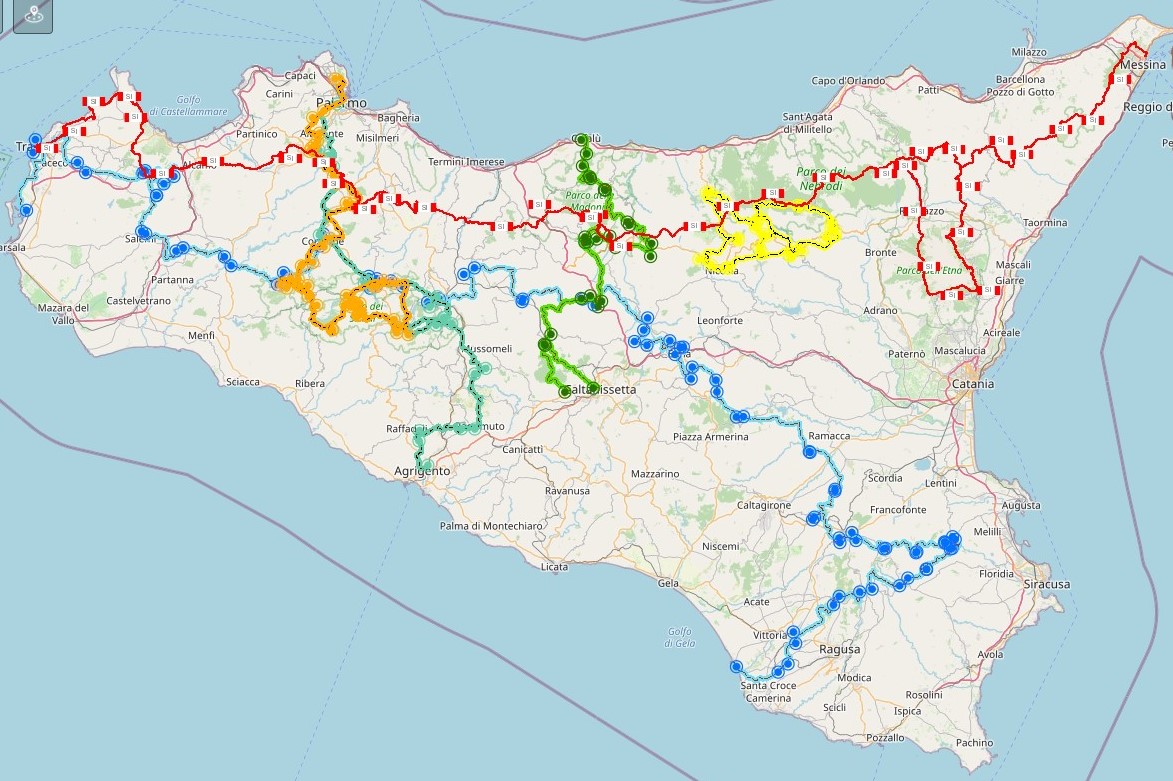Via Francigena Normanna
Detail
The Via Normanna is an important artery of the Sicilian Magna Via Francigena, witnessed since the Middle Ages through original documents attesting to Norman land donations in the then “terra Bucelli”.
Today, the so-called “Via dei Franchi”, the knights who came from Normandy to drive the Muslims out of Sicily, offers walkers a wonderful route through the mountains across northern Sicily, from Palermo to Messina.
The Norman Via Francigena in Sicily offers the excitement of an itinerary in the footsteps of Roger II (who walked it in 1115), Henry VI and Charles V. A unique 370-kilometre-long path, in 20 stages, combines the snow-capped peaks of the Madonie Mountains with the landscapes of the Peloritani Mountains, passing through the Nebrodi Mountains, retracing the historic route that led to the kingdom’s capital in antiquity.
The starting city for the itinerary along the Via Normanna is Palermo, a city that is part of the UNESCO circuit “Arab-Norman Palermo and the cathedrals of Cefalù and Monreale”, a Mediterranean capital to be discovered in all its charm.
The second stop on the Via Francigena Normanna, passing through the Hermitage of S. Felice (Caccamo), is Bagheria (PA), the “Baaria” of Tornatore’s film, which enchants us with its Baroque palaces and splendid villas, the birthplace of the painter Renato Guttuso.
We pass through Montemaggiore Belsito (PA) and reach Caltavuturo (PA), immersed in the Madonie Park. Overlooked by the Rocca di Sciara, the town is a Byzantine stronghold, rich in archaeological evidence and medieval remains.
The fifth stage of the Via Normanna passes through Polizzi Generosa (PA), whose name was given to it by Emperor Frederick II, and reaches the unmissable village of Petralia Sottana (PA), among the Orange Flag villages in Sicily.
The seventh stop on the Via Normanna is the village of Gangi (PA), one of Italy’s Most Beautiful Villages, with a delightful medieval historic centre, rich in fine buildings, and a painted landscape on the promontory.
The eighth stage of the route along the Via Francigena Normanna leaves the Madonie to reach the Nebrodi Park and Nicosia, in the province of Enna. The “City of San Nicolò” welcomes us with its Byzantine and Norman beauties and its typical “Gallo-Italic” dialect.
The stage to Capizzi (EN) and the next one, Capizzi-Troina (EN), again in the Nebrodi Mountains, leads us to the discovery of beautiful Baroque churches (Church of San Giacomo in Capizzi, which is also a stage of the Path of San Giacomo) and one of The Most Beautiful Villages in Italy, Troina, where Arabs and Jews coexisted in their respective quarters.
The eleventh stop on the Via Normanna itinerary is Cesarò, which introduces us to the province of Messina with the remains of its medieval castles and the natural oases of the Biviere and Maulazzo lakes.
We move on to the province of Catania and visit Randazzo, the twelfth stop along the route of the Norman Francigena. One of the most representative medieval centres in the region, its ancient gates provide access to the traces left by the Greeks, Romans, Byzantines, Jews, Arabs, Normans and Aragonese.
Passing through Floresta (ME) and the Sentiero Italia CAI, we reach Montalbano Elicona (ME), another of Italy’s Most Beautiful Villages in Sicily, the summer residence of Frederick III, famous for its Castle, Royal Chapel and Cathedral.
Fifteenth stop on the Via Normanna is Novara di Sicilia (ME), on the border between the Nebrodi and Peloritani mountains. A must-see is the Castle of Novara and the Cathedral of the Assumption, the most representative buildings of the mediaeval village at the foot of the fortress.
We reach the village of Castroreale (ME) for an authentic immersion in the Sicilian Middle Ages. The “Loyalty of Frederick II of Aragon” gives us towers, churches, convents, palaces and views that make it one of The Most Beautiful Villages in Italy.
Stage seventeen on the Via Normanna, Santa Lucia del Mela (ME), in the valley of the same name, stands in a picture-postcard location. A small medieval jewel, the town boasts Baroque churches, monumental palaces, the Castle of Santa Maria del Mela, archaeological remains and the Postoleone Lake.
Eighteenth stop, Rometta (ME) boasts ancient prehistoric necropolises, important Byzantine remains such as the Church and Monastery of the Cerei and the Borgo Storico Pantano, a “ghost town” with splendid rural vestiges.
Villafranca Tirrena (ME), the penultimate stop on the Via Normanna, offers the beauty of the Bauso Castle, its gardens and the panorama from the terrace. To visit, the Church of San Gregorio Magno and the Historical Museum of Medicine.
The section of the Via Francigena Normanna ends in Messina, a city to be discovered in several days, visiting the Cathedral (we recommend midday, to coincide with the chiming of the famous mechanical clock), the monumental fountains, the Galleria Vittorio Emanuele III, the museums, the panoramic shrines and the forts.
Find out more on the Via Normanna website.
Regional web map of paths and routes for soft mobility realised by LabGis Osservatorio Turistico della Regione Sicilia, in collaboration with FIAB Sicilia and CAI Sicilia.
Share this content!
LOCATION
DURATION
Distance
370 KM
Difficulty
High
Places
Categories
AROUND









